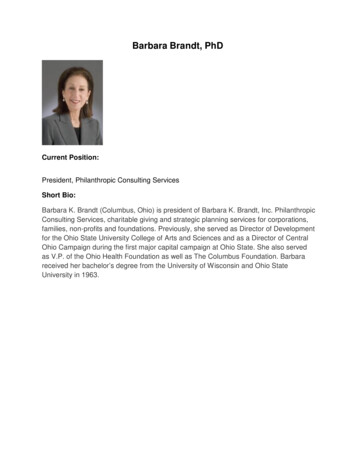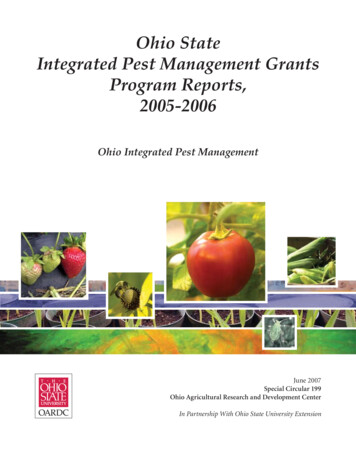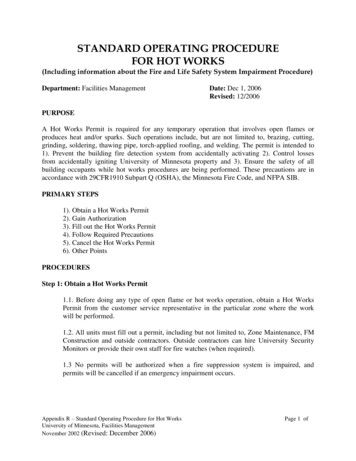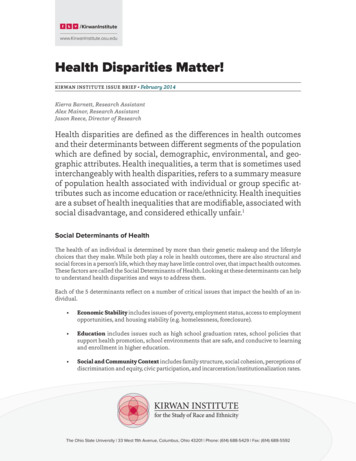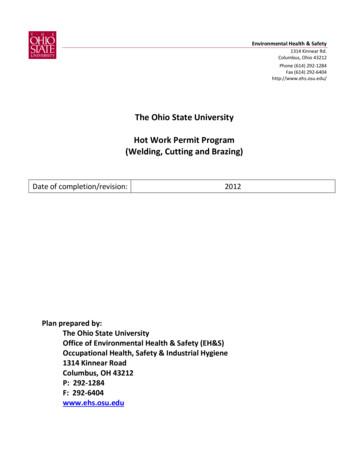
Transcription
Environmental Health & Safety1314 Kinnear Rd.Columbus, Ohio 43212Phone (614) 292-1284Fax (614) 292-6404http://www.ehs.osu.edu/The Ohio State UniversityHot Work Permit Program(Welding, Cutting and Brazing)Date of completion/revision:2012Plan prepared by:The Ohio State UniversityOffice of Environmental Health & Safety (EH&S)Occupational Health, Safety & Industrial Hygiene1314 Kinnear RoadColumbus, OH 43212P: 292-1284F: 292-6404www.ehs.osu.edu
Page 2Table of Contents1.0Introduction . 32.0Pre-Hot Work Activities . 63.0Specialized Hot Work Precautions . 84.0Personal Protective Equipment. 105.0Ventilation . 116.0Post-Hot Work Activities . 117.0Training . 128.0Recordkeeping . 12Appendix A: Hot Work Permit . 13Appendix B: NFPA 51-B . 15
Page 31.0 Introduction1.1 The following Hot Work Program provides written procedures to help prevent theoutbreak of fire, fire alarm activations, and smoke/odor migration in buildings resultingfrom work involving open flames, producing heat or sparks. This includes, but is notlimited to brazing, cutting, grinding, torch soldering, thawing pipes, and torch appliedroofing and welding.1.2 This procedure applies to hot work done at The Ohio State University (OSU) by OSUemployees. Contractors working in occupied OSU buildings must have their own writtenHot Work Program and submit copies of completed Hot Work Permits to OSUEnvironmental Health and Safety (EH&S).Contractors working at OSU construction sites (new buildings or unoccupied renovationsites) are required to have their own written Hot Work Program; completed Hot WorkPermits on construction sites are not required to be submitted to OSU EH&S.1.3 Responsibilities:1.3.1 Environmental Health & Safety:1.3.1.1 EH&S is responsible for maintaining the written Hot Work Program.1.3.1.2 EH&S is responsible for providing and maintaining Hot Work Permitsto OSU employees when notified of hot work activities. Additionally,EH&S staff conducts hot work permit inspections and approvals priorto hot work being done.1.3.1.3 EH&S accepts completed Hot Work Permits from contractorsperforming hot work activities in occupied OSU buildings. EH&S willprovide assistance to contractors upon request.1.3.2 Supervisors/Project Managers:1.3.2.1 Ensure employees conducting hot work have received proper trainingand are provided appropriate equipment and personal protectiveequipment to complete the job safely.1.3.2.2 Be capable of identifying hazards when hot work is anticipated.1.3.2.3 Ensure Hot Work Permits are completed and submitted to EH&S forapproval.1.3.2.4 Ensure hired contractors have their own Hot Work Program andprovide EH&S with completed permits.
Page 41.3.3 Authorized Employees:1.3.3.1 Authorized employees are those who have received appropriatetraining and possess adequate knowledge to safely conduct hot workand are responsible for the following:1.3.3.1.1 Ensure the safe handling of cutting or welding equipmentand safe use during the process.1.3.3.1.2 Determine the combustible materials and hazardous areaspresent or likely to be present in the work area.1.3.3.1.3 Protect combustible material from ignition by moving thehot work to a location free from dangerous combustibles;or, if not feasible, moving combustibles to a safe location orprovide shielding to prevent ignition.1.3.3.1.4 Ensure hot work operations do not interfere with otheroperations in the area.1.3.3.1.5 Notify EH&S of planned hot work and ensure appropriatehot work permits are complete prior to work.1.3.3.1.6 Ensure appropriate fire protection and extinguishingequipment are properly located at the site.1.3.3.1.7 Ensure a fire watch is present, when required.1.3.3.1.8 Ensure smoke/fire detection devices have been addressed.1.3.3.1.9 Ensure HVAC precautions have been addressed.1.3.4 Contractors:1.3.4.1 Contractors are hired by the university to either make renovations orrepairs to existing occupied facilities or to build or renovateunoccupied university facilities.1.3.4.2 All contractors hired to conduct hot work at The Ohio State Universityshould have their own written hot work program that fulfills allregulatory requirements.1.3.4.3 Contractors working in occupied OSU buildings shall notify EH&S thathot work is being completed and provide copies of all hot workpermits prior to commencing the work.
Page 51.3.4.4 Contractors working on new construction or renovating unoccupieduniversity facilities shall follow their own hot work policies andprocedures, which shall fulfill all regulatory requirements.1.4 Definitions:1.4.1 Hot Work:Any operation producing flames, sparks or heat includingcutting, welding, brazing, grinding, torch soldering, thawing frozen pipes,applying roof coverings, etc.1.4.2 Hot Work Permit:A specific permit, which authorizes “Hot Work”activities at a specific location and time. This permit must be completedproperly and displayed on the worksite until hot work is complete; and mustbe retained on file by the supervisor. Permits contain checklists to becompleted prior to and after hot work activities.1.4.3 Fire Watch: A trained individual stationed in the hot work area who isassigned to monitor the work area for the beginnings of potential, unwantedfires both during and after hot work. Individuals must be trained and familiarwith the operation of portable fire extinguishers and methods to activatebuilding alarm systems.
Page 62.0 Pre-Hot Work Activities2.1 All hot work activities are required to have a Hot Work Permit, unless the welding,cutting or brazing operations are being conducted in an area/shop designed to facilitatesafe hot work operations.2.2 If possible, move hot work activities to a safe area free from all combustible materialsand fire hazards.2.3 If hot work activities cannot be relocated to a safe area, the following precautions mustbe taken, in addition to acquiring the proper Hot Work Permit, to ensure fire, and otherhazards, are addressed prior to hot work commencing:2.3.1 Hot work permits are posted at the entrance to the work site to informpersonnel of the hot work operations taking place.2.3.2 Smoke detectors and sprinkler systems have been addressed by the FacilitiesOperations and Development (FOD) Fire Safety staff.2.3.3 Heating, Ventilation and Air Conditioning (HVAC) have been addressed byFOD Building Automation staff.2.3.3.1 Ducts that might carry sparks to a distant combustible material mustbe suitably protected or disengaged.2.3.4 Welding and cutting equipment is in proper working order.2.3.5 First aid supplies are readily available.2.3.6 Precautions have been taken to protect the area within 35 feet of the hotwork area:2.3.6.1 Floors are swept clean of dust and combustibles.2.3.6.2 Combustible floors are wetted or covered with damp sand, metal orother suitable shields.2.3.6.3 No combustible materials or flammable liquids are present.2.3.6.4 Combustible surfaces are protected with covers, guards or metalshields.2.3.6.5 Combustible materials in adjacent rooms are moved away from walls.2.3.6.6 All wall and floor openings are covered, blocked or shielded.
Page 72.3.6.7 Grated floors (i.e. catwalks) are protected to ensure collection ofsparks during work.2.3.7 Precautions within 50 feet of the hot work area:2.3.7.1 Relocate or protect explosive material, compressed gas cylinders orstored fuel.2.3.8 A fire watch is established and assigned to a properly trained individual.2.4 Fire Watch: During and after hot work activities, the work area must be monitored toensure hot work does not result in a fire.2.4.1 Personnel assigned to fire watch responsibilities must be trained in thecontents of the Hot Work Program and fire extinguisher use and limitations.2.4.2 Fire watch must be conducted during and at least 30 minutes following thehot work activity.2.4.3 Appropriate fire extinguishing equipment must be readily available during firewatch.2.4.4 Fire watch personnel must have the ability to sound the fire alarm and alertthe responding Fire Department in the event of a fire.2.5 Prior to commencement of hot work, an EH&S representative will inspect the work areaand confirm the aforementioned precautions have been taken to prevent fire inaccordance with NFPA 51B (Appendix B). It is the responsibility of the person conductingthe hot work, or their supervisor, to notify EH&S of the scheduled work in a timelymanner to ensure EH&S has sufficient time to respond to the request.2.6 Prohibited Areas: Cutting or welding shall not be permitted in the following situations:2.6.1 In unauthorized areas, such as occupied office space2.6.2 In sprinklered buildings, while such protection is impaired2.6.3 In the presence of explosive atmospheres or potential for explosiveatmospheres2.6.4 In areas near the storage of large quantities of exposed readily ignitablematerials2.6.5 In areas not approved by EH&S through the hot work permitting process.
Page 83.0 Specialized Hot Work Precautions:3.1 Pipes:3.1.1 Prior to cutting or welding on pipes, the operator must ensure the pipes arepurged and empty.3.1.2 Cutting or welding on pipes or other metal in contact with combustible walls,partitions, ceilings or roofs shall not be undertaken if the work is close enoughto cause ignition by conduction.3.2 Containers:3.2.1 No welding, cutting or other hot work shall be performed on used drums,barrels, tanks or other containers until they have been cleaned to ensure noflammable materials or vapors are present.3.2.2 Pipes connected to containers must be disconnected prior to hot work.3.2.3 All hollow spaces, cavities, or containers must be vented during the hot workto permit the escape of air and gases. Purging with inert gas isrecommended.3.3 Confined Space:3.3.1 If hot work activities are to take place in a confined space the operator mustbe trained under and follow all components of the Confined Space EntryProgram.3.3.2 Prior to hot work in a confined space the following precautions must beaddressed:3.3.2.1 Ensure a confined space entry permit is completed3.3.2.2 Ensure all openings/covers are open and secured from closing3.3.2.3 Test atmosphere within the confined space for oxygen, explosives, andtoxins3.3.2.4 Isolate lines and maintain vents open and valves leak-free3.3.2.5 Lockout/tagout all systems not required during hot work.3.3.2.6 Provide a means for readily turning off power, gas and other suppliesfrom outside the confined space.
Page 93.3.2.7 Protect or remove any hazardous materials which may becomehazardous when exposed to hot work.3.3.3 Ventilation within the confined space must be supplied to ensure fumes andgases do not exceed exposure limits and oxygen limits remain within anacceptable range.3.3.3.1 If ventilation is not possible, the operators must be provided airlinerespirators or a self-contained breathing apparatus to ensure saferespirable air at all times. Respiratory protection users must havemedical clearance and be included in the University RespiratoryProtection Program.3.3.4 Gas cylinders and welding machines must be left outside the confined spaceand secured to prevent movement during hot work operations.3.3.5 Where an operator must enter a confined space through a manhole or othersmall opening, means must be provided to quickly remove (rescue) theoperator in an emergency (i.e. lifeline).3.3.6 When breaks in hot work occur (lunch or overnight) all valves must be turnedoff and hoses and connections must be disconnected at the power source.
Page 104.0 Personal Protective Equipment4.1 Operators performing hot work, and any personnel assigned to the hot work project asassistants must be provided appropriate personal protective equipment (PPE).4.1.1 Eye Protection: Suitable eye protection must be provided and worn byoperators and assistants during all hot work operations.4.1.1.1 PPE used for eye protection such as goggles, helmets and hand shieldsmust meet minimum ANSI standards.4.1.1.2 Table 1 provides recommendations for selection of the proper shadenumbers for eye protection based on the type of hot work being done.Table 1:Welding OperationShielded metal-arc welding(1/16, 3/32, 1/8, 5/32-inch electrodes)Gas-shielded arc welding (nonferrous)(1/16, 3/32, 1/8, 5/32-inch electrodes)Gas-shielded arc welding (ferrous)(1/16, 3/32, 1/8, 5/32-inch electrodes)Shielded metal-arc welding(3/16, 7/32, 1/4-inch electrodes)Shielded metal-arc welding(5/16, 3/8-inch electrodes)Atomic hydrogen weldingShade Number101112121410-14Carbon arc welding14Soldering2Torch brazingLight cutting(up to 1-inch)Medium cutting(1-6-inches)Heavy cutting(6-inches and over)Light gas welding(up to 1/8-inch)Medium gas welding(1/8 to 1/2-inch)Heavy gas welding(1/2-inch and over)3-43-44-55-64-55-66-8
Page 114.1.2 Protective clothing: Heat resistant clothing must be provided and worn byoperators during hot work operations.4.1.3 Other PPE including head, hand and foot protection shall be provided basedon the hazard evaluation of the work area and work to be completed.4.1.4 Screens shall be utilized to provide protection to the worker as well as othersnot involved in the hot work.5.0 Ventilation5.1 Ventilation must be adequate during general welding and cutting hot work operations.5.2 Mechanical ventilation must be provided when welding or cutting operations take place:5.2.1 In a space less than 10,000 cubic feet per welder;5.2.2 In a room having a ceiling height of less than 16 feet;5.2.3 In a confined space;5.2.4 In a space containing partitions, balconies or other structural barriers, whichmay significantly obstruct ventilation.5.3 Ventilation should be provided at a rate of 2,000 cubic feet per minute (CFM) per welderunless local exhaust hoods, booths, or supplied breathing air is provided in the workarea.5.4 Natural ventilation will be considered sufficient where the restrictions in 5.2 of this planare not present.5.5 Cutting or welding operations involving hazardous materials must be pre-approved andreviewed by EH&S prior to work.6.0 Post-Hot Work Activities6.1 Upon completion of hot work operations, the fire watch personnel must remain on sitefor at least 30 minutes to ensure fire hazards are mitigated.6.2 Upon completion of the fire watch, the attendant must sign the hot work permitindicating the hot work is complete.6.3 As a precautionary measure, it is recommended the hot work area be inspected again atthe end of the shift to ensure fire hazards or potential fires are properly handled.
Page 127.0 Training7.1 Supervisors must ensure all hot work operators, fire watch personnel and assistantsreceive training relating to hot work operations.7.2 Training shall cover all aspects of the hot work program including:7.2.1 Pre-hot work operations7.2.2 Completion of hot work permits7.2.3 Personal protective equipment7.2.4 Ventilation7.2.5 Post-hot work operations8.0 Recordkeeping8.1 Hot work permit8.1.1 A copy of the hot work permit must be maintained by the shop performingthe hot work operations and EH&S.8.2 Training records8.2.1 Training records are maintained by the employing department in theemployees employment file. Records for training provided by EH&S will bemaintained by EH&S but should also be kept in the employment file.
Page 13Appendix A – Hot Work Permit
Page 14
Page 15Appendix B – NFPA 51B: Standard for Fire Prevention During Welding, Cutting and other HotWork
Page 16
Page 17
Page 18
Page 19
Page 20
Page 21
Page 22
Page 23
Page 24
Page 25
Page 26
Page 27
Page 28
Page 29
Page 30
Page 31
Page 32
Page 33
2.2 If possible, move hot work activities to a safe area free from all combustible materials and fire hazards. 2.3 If hot work activities cannot be relocated to a safe area, the following precautions must be taken, in addition to acquiring the proper Hot Work Permit, to ensure fire, and other hazards, are addressed prior to hot work commencing:



